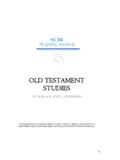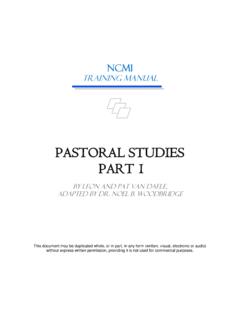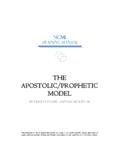Transcription of BIBLE SURVEY : WHAT - NCMI Global - Home
1 1 NCMI TRAINING MANUAL NEW TESTAMENT STUDIES By Nigel Day-Lewis This document may be duplicated whole, or in part, in any form (written, visual, electronic or audio) without express written permission, providing it is not used for commercial purposes. 2 BIBLE SURVEY : introduction (WHAT? WHY? HOW?) A BIBLE SURVEY is an attempt to overview, in one sweep, the content of the entire BIBLE . It aims to introduce the student to all of Scripture. That is, it aims to give to the student the historical background to, the structure (outline) of, and any other interpretative keys (main themes, key concepts, literary features, etc) within, each division and each book of the BIBLE , so that he/she can henceforth more profitably read and study the BIBLE for him/herself, whether for personal devotions or public ministry.
2 A BIBLE SURVEY is thus not a BIBLE Study or a series of BIBLE Studies: when we are seeking to cover the entire BIBLE there is obviously not enough time for the detailed study (whether devotional or doctrinal) of biblical passages, themes, etc. Nor is a BIBLE SURVEY the same as Biblical Studies, the more academic subject offered in many institutions which focuses on the origins and reliability of the text. A BIBLE SURVEY thus necessarily involves the frustration of having to skim over countless rich veins of Scripture that beg for deeper excavation. But if the effect of the SURVEY is to inspire people to do some excavating, then it has succeeded!
3 The advantages far outweigh the disadvantages. One benefit of a BIBLE SURVEY is that it gives one a grasp of the whole: one is able to see all of God's revelation about himself, and all of his dealings with man through all ages, at a glance. Consequently, my own experience, and that of many others, upon completing a SURVEY , has been a greatly increased understanding of, and depth of relationship with, God. This increase has, in turn, revolutionised our faith, our vision and our obedience. Another advantage is this: many Christians, even believers of long-standing, are limited in their enjoyment and understanding of Scripture to the New Testament and the odd Psalm (less than one quarter!)
4 A SURVEY opens up all of Scripture to the believer, so that he/she can enjoy the full orb of its riches - even heavy Levi [ticus], chronic Chronicles and lamenting Lamentations! No area of knowledge is more basic to and more important for, the Christian than Scripture; it has thus always been my conviction and still remains so, that a BIBLE SURVEY is the most important course a Christian can do. Whether you are working through this manual on your own or doing so as part of a formal course for which you have registered, I recommend you complete each of these three steps for each chapter (lecture) in order to gain the maximum possible benefit from your SURVEY : (i) read the relevant book(s) in the BIBLE ; (ii) carefully work through the lecture material; (iii) complete one of the suggested assignments.
5 Many Christians have never read the BIBLE through from cover to cover. A BIBLE SURVEY presents the perfect opportunity to do so - an exercise eminently worthwhile in its own right even without the lectures. Reading through the BIBLE as you SURVEY it will greatly increase your understanding of the lecture material and your benefit from the course as a whole. In fact, I would suggest that surveying the BIBLE without reading it would be meaningless. The book(s) to be read for each lecture are shown on the contents page and at the head of each chapter. You can read the relevant book(s) either before or after you read the corresponding chapter in the manual.
6 The advantage of reading the BIBLE first is that the lecture notes will be more meaningful. Conversely, reading the notes first may make the BIBLE -reading more meaningful. Try to keep up to date; but, if you have to move on to the next chapter (most Surveys will do a chapter a week), move onto the next week's reading and return to unfinished reading later in the semester or once the semester is over. To help you keep a record of what you have read and what you have still to read, I have included a reading checklist with each module. Simply tick off each chapter as you read it. Your course may have prescribed assignment topics for you.
7 If not, or if you are working on your own, you will find a list of suggested topics at the end of this manual - and a list of recommended reference works which you may find useful. Your own research, like reading the BIBLE , will make any BIBLE SURVEY more rewarding: one's own discoveries are always the most exciting and long-remembered. 3 BIBLE SURVEY : COURSE OUTLINE New Testament 1. The Inter-Testament Period introduction to the New Testament 2. The Synoptic Gospels Matthew, Mark, Luke 3. The Fourth Gospel John 4. The Early Church Acts 5. Paul's Second Journey Epistles 1 & 2 Thessalonians, Galatians 6.
8 Paul's Third Journey Epistles (1) 1 & 2 Corinthians 7. Paul's Third Journey Epistles (2) Romans 8. Paul's Prison Epistles Ephesians, Colossians, Philemon, Philippians 9. Paul's Pastoral Epistles 1 & 2 Timothy, Titus 10. The General Epistles: (1) Suffering Hebrews, James, 1 Peter 11. The General Epistles: (2) Heresy 2 Peter, Jude, 1 & 2 & 3 John 12. The Apocalypse Revelation 4 CONTENTS Page No: Author's Preface 5 Reading Checklist 6 1. The Inter-Testament Period introduction to the New Testament 7 2. The Synoptic Gospels Matthew, Mark, Luke 15 3. The Fourth Gospel John 19 4.
9 The Early Church Acts 26 5. Paul's Second Journey Epistles 1 & 2 Thessalonians, Galatians 31 6. Paul's Third Journey Epistles (1) 1 & 2 Corinthians 36 7. Paul's Third Journey Epistles (2) Romans 41 8. Paul's Prison Epistles Ephesians, Colossians, Philemon, Philippians 47 9. Paul's Pastoral Epistles 1 & 2 Timothy, Titus 51 10. The General Epistles: (1) Suffering Hebrews, James, 1 Peter 54 11. The General Epistles: (2) Heresy 2 Peter, Jude, 1 & 2 & 3 John 58 12. The Apocalypse Revelation 61 Suggested Assignments 68 Recommended References 70 _____ 5 AUTHOR S PREFASE I have had the privilege of presenting all or parts of a BIBLE SURVEY in various places over the past twelve years.
10 This manual is a reorganization of my most recent presentation of each lecture. As such, it is neither final nor perfect: I hope to upgrade each chapter with each presentation, and any suggestions to this end are always appreciated. Further, while I have tried to present information and interpretation consistent with historic, orthodox, evangelical Christianity, the opinions expressed in places are mine only. They should in no way be taken as necessarily representing the position of those who may prescribe this manual for a formal course of study. I want to thank the many people over the years who have played a part in the development of this course: the leaders who invited me to present it; the students who encouraged me while doing it; the typists who helped with the preparation of the notes at each stage; my computer boffs, Charles Reekie and Wojtek Kukulski, for the diagrams in this manual; and Kirsten, for the cover.



